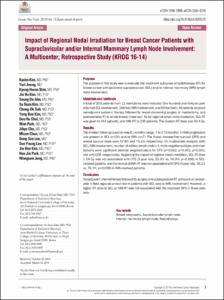KUMEL Repository
1. Journal Papers (연구논문)
1. School of Medicine (의과대학)
Dept. of Radiation Oncology (방사선종양학)
Impact of Regional Nodal Irradiation for Breast Cancer Patients with Supraclavicular and/or Internal Mammary Lymph Node Involvement: A Multicenter, Retrospective Study (KROG 16-14)
- Keimyung Author(s)
- Kim, Jin Hee
- Department
- Dept. of Radiation Oncology (방사선종양학)
- Journal Title
- Cancer Research and Treatment
- Issued Date
- 2019
- Volume
- 51
- Issue
- 4
- Abstract
- Purpose
The purpose of this study was to evaluate the treatment outcomes of radiotherapy (RT) for breast cancer with ipsilateral supraclavicular (SCL) and/or internal mammary (IMN) lymph node involvement.
Materials and Methods
A total of 353 patients from 11 institutions were included. One hundred and thirty-six patients had SCL involvement, 148 had IMN involvement, and 69 had both. All patients received neoadjuvant systemic therapy followed by breast-conserving surgery or mastectomy, and postoperative RT to whole breast/chest wall. As for regional lymph node irradiation, SCL RT was given to 344 patients, and IMN RT to 236 patients. The median RT dose was 50.4 Gy.
Results
The median follow-up duration was 61 months (range, 7 to 173 months). In-field progression was present in SCL (n=20) and/or IMN (n=7). The 5-year disease-free survival (DFS) and overall survival rates were 57.8% and 75.1%, respectively. On multivariate analysis, both SCL/IMN involvement, number of axillary lymph node ≥ 4, triple-negative subtype, and mastectomy were significant adverse prognosticators for DFS (p=0.022, p=0.001, p=0.001, and p=0.004, respectively). Regarding the impact of regional nodal irradiation, SCL RT dose≥ 54 Gy was not associated with DFS (5-year rate, 52.9% vs. 50.9%; p=0.696) in SCLinvolved patients, and the receipt of IMN RT was not associated with DFS (5-year rate, 56.1% vs. 78.1%; p=0.099) in IMN-involved patients.
Conclusion
Neoadjuvant chemotherapy followed by surgery and postoperative RT achieved an acceptable in-field regional control rate in patients with SCL and/or IMN involvement. However, a higher RT dose to SCL or IMN RT was not associated with the improved DFS in these patients.
- Keimyung Author(s)(Kor)
- 김진희
- Publisher
- School of Medicine (의과대학)
- Citation
- Kyubo Kim et al. (2019). Impact of Regional Nodal Irradiation for Breast Cancer Patients with Supraclavicular and/or Internal Mammary Lymph Node Involvement: A Multicenter, Retrospective Study (KROG 16-14). Cancer Research and Treatment, 51(4). doi: 10.4143/crt.2018.575
- Type
- Article
- ISSN
- 2005-9256
- Source
- https://www.e-crt.org/journal/view.php?doi=10.4143/crt.2018.575
- Appears in Collections:
- 1. School of Medicine (의과대학) > Dept. of Radiation Oncology (방사선종양학)
- 파일 목록
-
-
Download
 oak-2019-0095.pdf
기타 데이터 / 352.36 kB / Adobe PDF
oak-2019-0095.pdf
기타 데이터 / 352.36 kB / Adobe PDF
-
Items in Repository are protected by copyright, with all rights reserved, unless otherwise indicated.